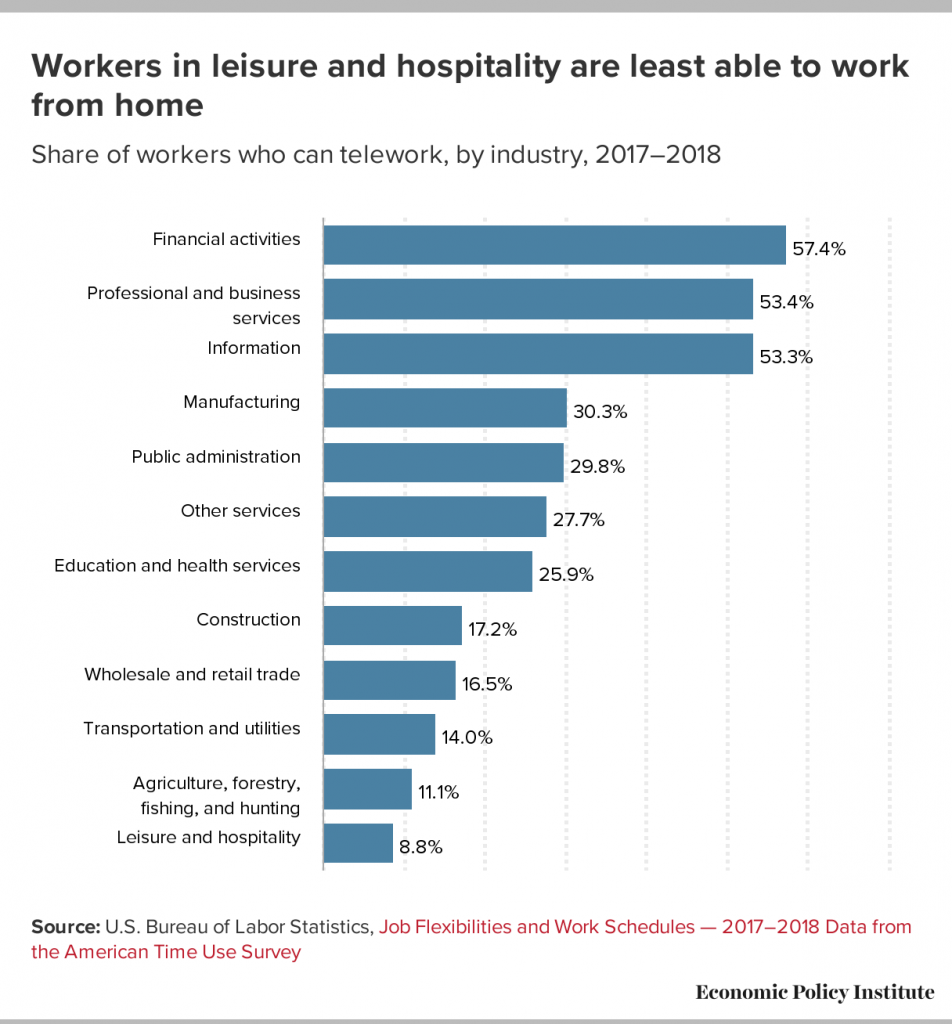By Elise Gould, PhD, senior economist, Economic Policy Institute
Heidi Shierholz, PhD, senior economist and policy director, Economic Policy Institute
Economic Policy Institute, March 19, 2020
Not everybody can work from home

The commonly paired statements that “everyone is working from home” and “everyone is having their goods delivered” amid the coronavirus outbreak ignores a whole segment of the workforce—the ones prepping and delivering their purchases. In fact, less than 30% of workers can work from home, and the ability to work from home differs enormously by race and ethnicity.
The chart below separates the share of workers who can telework for the three largest race groups as well as by Hispanic ethnicity (these groups are not mutually exclusive in these data). Asian workers are the most likely to be able to work from home, followed by non-Hispanic and white workers. Only 16.2% of Hispanic workers and 19.7% of black workers can telework.

The next figure illustrates the share of workers who can telework by wage. Not surprisingly, low-wage workers have the least flexibility in their jobs: Only 9.2% of workers in the lowest quartile of the wage distribution can telework compared with 61.5% of workers in the highest quartile.

Further, a great share of these workers who can’t work from home are in the leisure and hospitality industry. As seen in the figure below, only 8.8% of leisure and hospitality workers are able to telework, versus more than 50% of workers in financial activities, professional and businesses services, and information.

These workers who cannot work from home—particularly those in retail and hospitality—also find their jobs at risk as social distancing keeps people from engaging in their normal activities. And workers who must continue to go to work, including all the health care workers on the front lines of the fight against the pandemic, are putting their health at risk.
To make matters worse, those who have children have to navigate continuing to work while also providing adequate care for their children as schools shut their doors. Among all workers, only 34.9% of parents in households with children can telework. This means that not only are their jobs vulnerable, but the care of their children may be as well.
Congress has begun to address the crisis with passage of the Family First Coronavirus Response Act, which provides, among other things, limited increases to paid sick leave coverage, nutrition assistance, and unemployment insurance. But it’s not nearly enough. There are substantial loopholes in the paid sick coverage provided, and it will do little to help the estimated 3 million workers, including 900,000 leisure and hospitality workers, who will lose their jobs by this summer.
In short, the federal government needs to fuel household consumption by greatly expanding unemployment insurance benefits and sending payments directly to U.S. families; giving substantial aid to state and local governments; providing tax credits to encourage businesses not to lay off workers; making direct government purchases of medical equipment and testing research and technology to fight the virus; and keep making all those investments while conditions warrant it.
In the meantime, it’s important to remember those workers who continue to go to their workplaces because that’s the only way they can financially support themselves and their families.











